



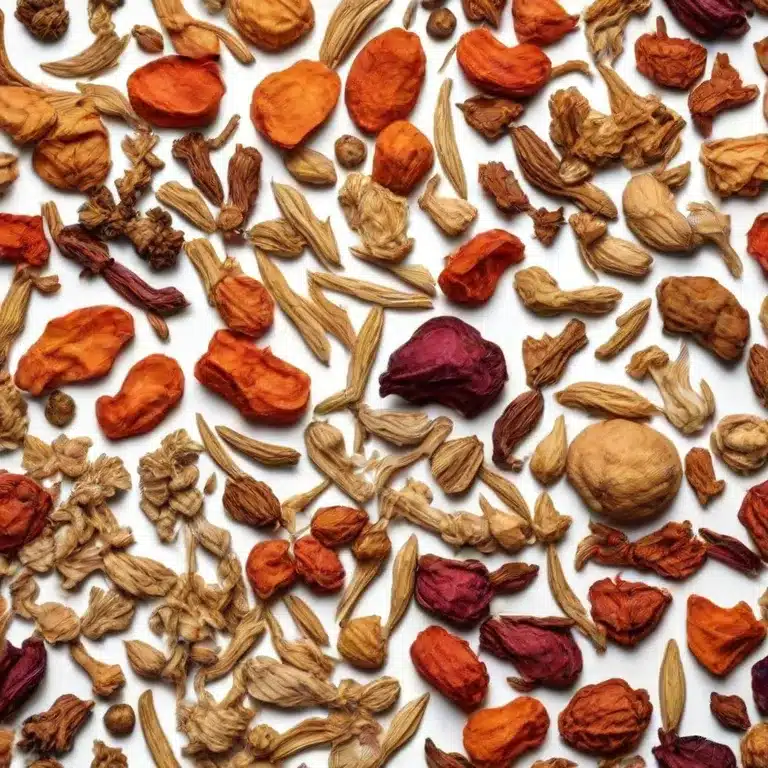
Dried vegetables are a convenient and versatile option for preserving the nutritional value of fresh produce. With a longer shelf life compared to fresh vegetables, dehydrated veggies offer a low-fat alternative for those looking to maintain a healthy diet.
How do dried vegetables stack up against their fresh and frozen counterparts? Are there any risks or drawbacks to consider? This article will explore all things dried vegetables, from how they’re made to popular types and ways to incorporate them into meals.
Dried vegetables are a convenient and long-lasting way to preserve the nutritional value of vegetables, making them a healthy addition to any diet.
Compared to fresh and frozen vegetables, dried vegetables have a longer shelf life and are a low-fat option for preserving essential nutrients.
Dried vegetables offer versatility in cooking and can be easily incorporated into various dishes, such as soups, stews, and as a healthy snack or side dish.
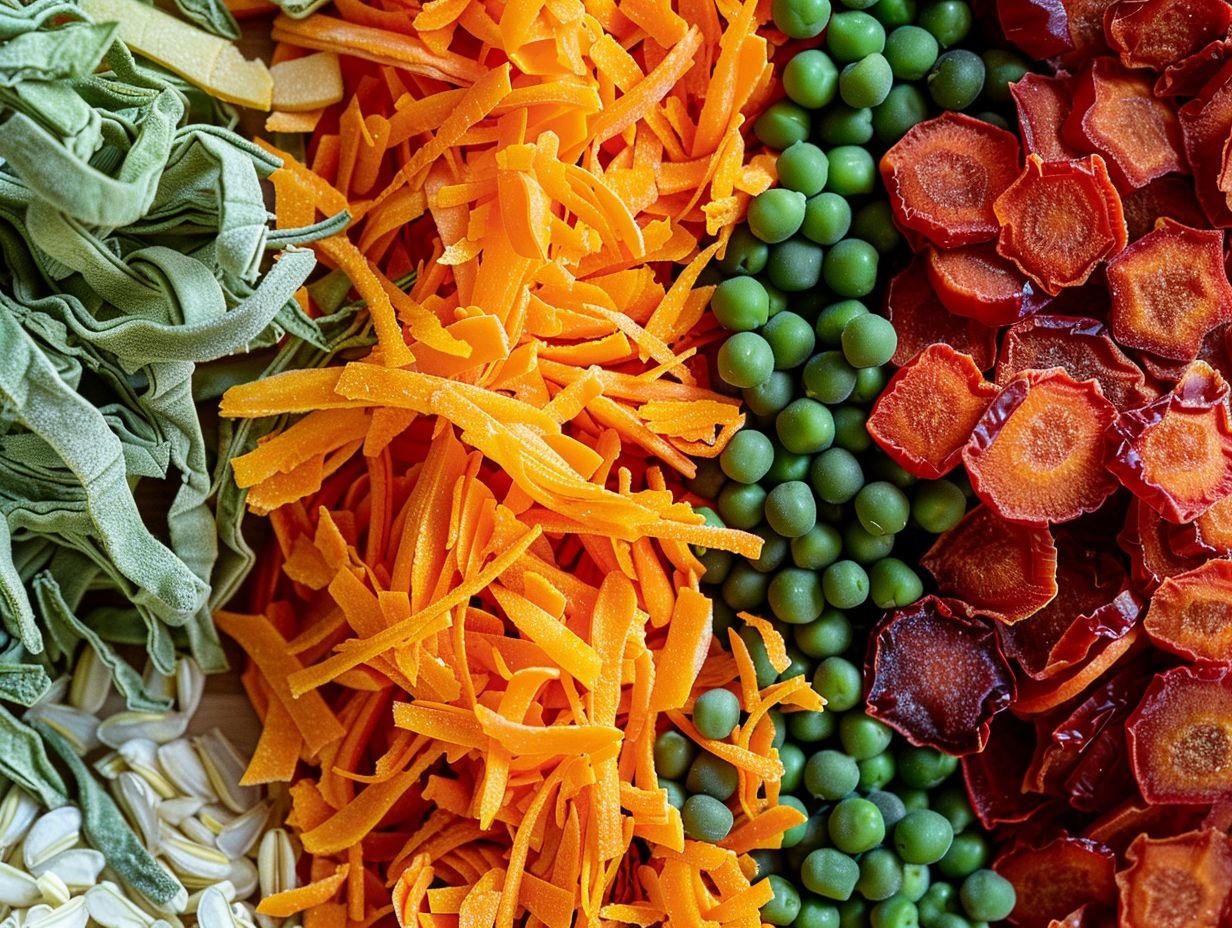
Dried vegetables are vegetables that have undergone a dehydration process to remove their moisture content, resulting in a shelf-stable and nutrient-dense food product.
During the dehydration process, the water is removed from the vegetables, allowing them to be stored for extended periods without refrigeration. This preservation method not only prolongs the shelf life but also concentrates the flavors, making dehydrated veggies a versatile ingredient in various dishes.
Nutritional value is another key aspect of dried vegetables. Although the dehydration process reduces certain water-soluble vitamins, minerals, and enzymes, the overall nutrient content remains relatively high. Dehydrated vegetables retain a significant amount of fiber, antioxidants, and essential nutrients, making them a convenient and healthy option for adding to meals.
Dried vegetables are an excellent option for preserving vegetables because they maintain their nutritional content and have a longer shelf life compared to fresh produce.
Dried vegetables retain a significant portion of their dietary fiber, vitamins, and minerals, making them a concentrated source of essential nutrients.
For example, a serving of dried peas can contain nearly the same amount of vitamin C and B vitamins as fresh peas, due to minimal nutrient loss during the drying process. Dried vegetables like tomatoes and bell peppers are excellent sources of essential minerals such as potassium and magnesium. In fact, studies have shown that the dehydration process retains up to 90% of the original nutritional value of vegetables, making dried vegetables a convenient and long-lasting option for ensuring a nutrient-rich diet.
When comparing dried vegetables to fresh and frozen vegetables, it’s important to consider the nutrient retention and convenience offered by each type.
While fresh vegetables are known for their vibrant taste and high nutrient content, they can lose some of their nutritional value over time due to exposure to light, heat, and air. On the other hand, frozen vegetables are harvested at peak ripeness and quickly frozen to lock in their nutrients, making them a close alternative to fresh produce. Dried vegetables, on the other hand, undergo a dehydration process that removes most of the water content, allowing them to have a longer shelf life and retain nutrients for an extended period of time. This makes dried vegetables a convenient option for those looking to stock up on nutritious ingredients without worrying about spoilage. The concentrated nature of dried vegetables makes them a versatile ingredient that can be easily incorporated into various dishes for added flavor and nutrition.
Consuming dried vegetables offers numerous health benefits, including the intake of extra nutrients, a longer shelf life, and the convenience of having a shelf-stable food product.
Dried vegetables offer convenience and a longer shelf life, especially when properly stored in a dark place, making them a practical option for food preservation.
One of the key benefits of dried vegetables is their ability to retain their nutritional value for an extended period, due to the dehydration process which helps preserve essential vitamins and minerals.
Their lightweight nature makes them ideal for hiking, camping, or simply as a backup option in your pantry, providing a quick and easy way to add vegetables to your meals without worry of spoilage.
To ensure dried vegetables remain shelf-stable, it is important to store them in airtight containers to prevent exposure to moisture and humidity, which can degrade their quality and shorten their shelf life.
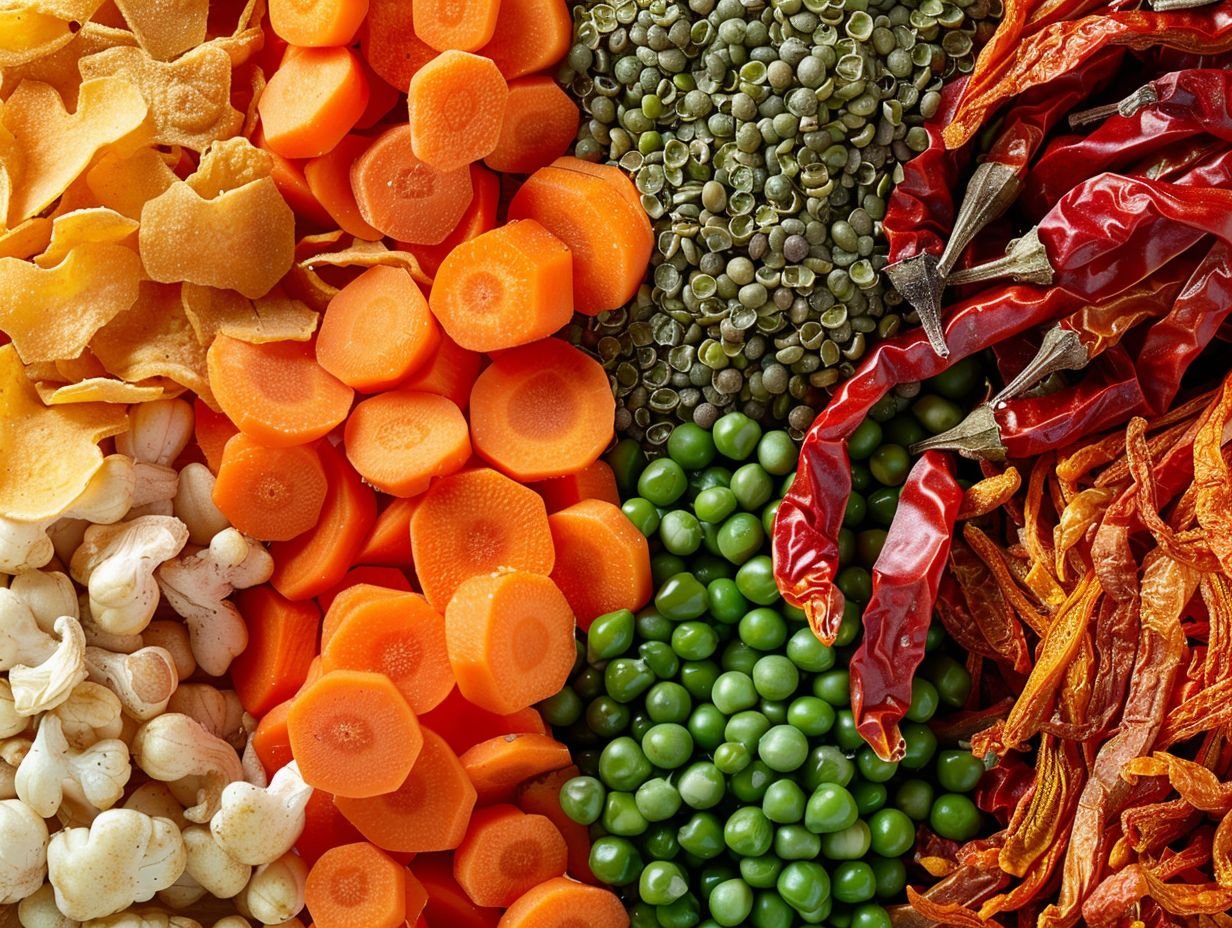
One of the significant advantages of dried vegetables is the retention of their nutritional value, including essential vitamins and minerals.
When vegetables are dehydrated, the process involves removing the water content from the produce. This drying method is crucial as it locks in the vitamins, minerals, and dietary fiber present in the vegetables.
Dehydration helps in preserving the nutritional density of the vegetables, making them a convenient and long-lasting option for incorporating essential nutrients into your diet.
Dried vegetables are a low-fat option for preserving vegetables, making them a healthy choice for those looking to reduce their fat intake.
Compared to other preservation methods, such as canning or freezing, dehydrating foods maintains their nutritional value without the need for additional fats. This is particularly beneficial for individuals aiming to follow a low-fat diet while still enjoying flavorful and nutrient-rich vegetables.
Dehydrated vegetables are convenient for snacking, cooking, or adding to soups and stews, providing a versatile option for incorporating more plant-based foods into daily meals. The dehydration process also enhances the natural flavors of vegetables, making them a tasty addition to various dishes.
Dried vegetables are incredibly versatile in cooking and can be easily incorporated into a variety of dishes such as soups and stir fries.
One of the most convenient aspects of using dried vegetables in cooking is their long shelf life, making them a practical pantry staple. Whether you’re making a hearty vegetable soup on a busy weeknight or adding a pop of flavor to a simple stir-fry, dried vegetables offer a quick and easy way to enhance your dishes without compromising on taste.
The concentrated flavors of dried vegetables can add depth and complexity to dishes, elevating the overall taste profile. Along with their flavor-enhancing properties, dried vegetables also retain their nutritional value, making them a healthy addition to any meal.
The process of making dried vegetables involves various drying methods, including sun drying, air drying, and using a food dehydrator, each of which removes the moisture content while preserving the nutritional value of the vegetables.
Sun drying is one of the oldest methods of drying vegetables, relying on natural sunlight to remove moisture content.
This traditional technique dates back centuries, with roots tracing to ancient civilizations using the sun’s rays to preserve crops for long-term storage. Sun drying not only extends the shelf life of vegetables but also intensifies their flavors, creating a unique depth in dishes. To effectively sun dry vegetables, it’s essential to slice them uniformly, placing them on drying racks or sheets in a sunny, well-ventilated area.
Air drying involves exposing vegetables to air circulation, allowing them to dry naturally without the use of heat.
One of the main benefits of air drying is that it helps retain the vegetables’ nutrients and flavors that might be lost with other drying methods. Air drying is a cost-effective and energy-efficient way to preserve vegetables compared to methods that require electricity or gas.
Compared to techniques like freeze-drying or dehydrating, air drying is a simple and traditional method that requires minimal equipment and can be done at home without any special tools.
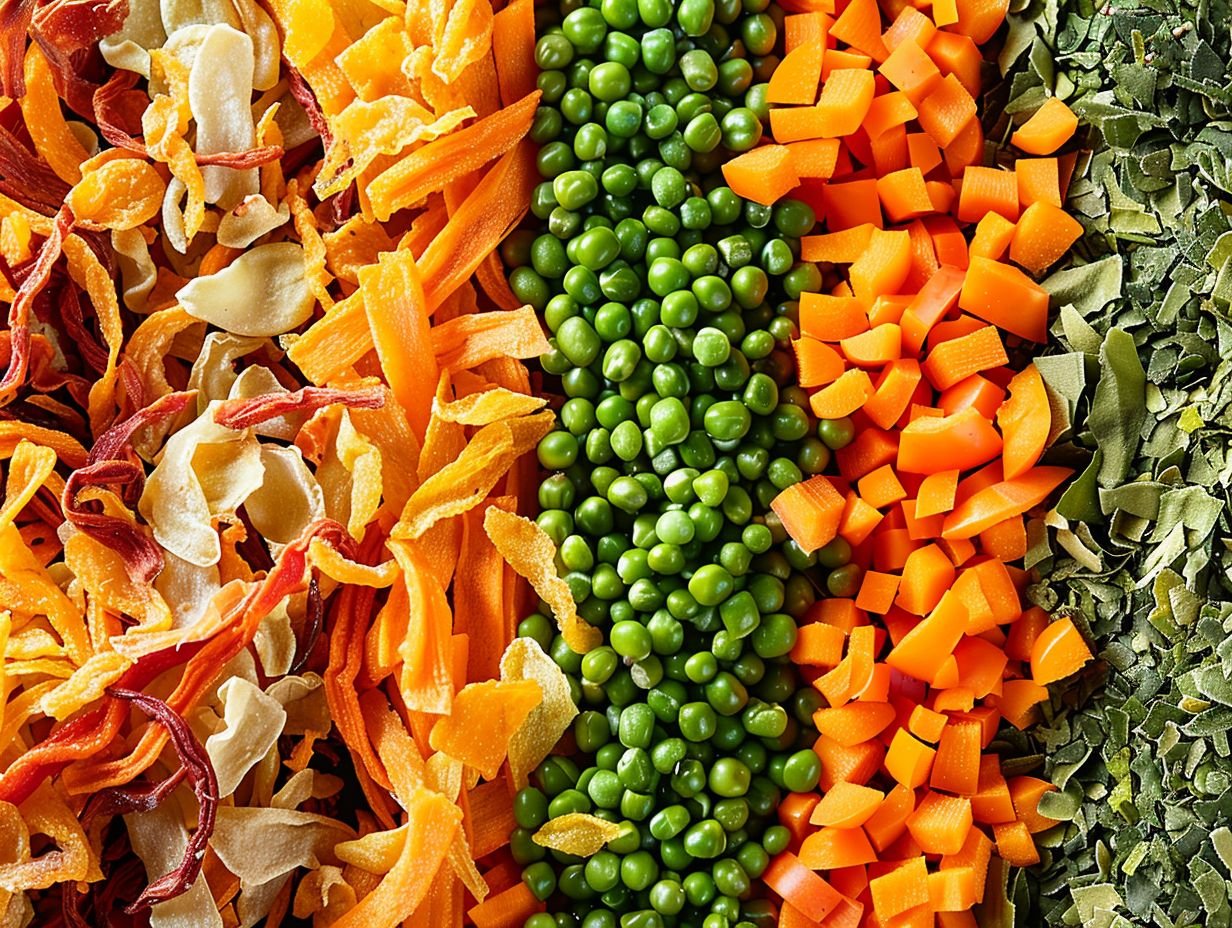
Oven drying is a controlled method that uses low temperatures to remove moisture content from vegetables.
When preparing for oven drying, it is crucial to slice the vegetables uniformly to ensure they dry evenly. To start the process, preheat the oven to a low temperature, typically around 140-160 degrees Fahrenheit. Placing the vegetable slices on a wire rack or parchment-lined baking sheet allows for proper air circulation, aiding in the drying process. Keep a close eye on the vegetables as they dry, flipping them occasionally for even drying. This method helps retain the nutrients in the vegetables while preserving them for future use.
While dried vegetables offer numerous benefits, there are potential risks and drawbacks to consider, such as the loss of some moisture content and possible changes in texture and flavor.
Some commercially available dried vegetables might have high sodium content, which can pose health risks if consumed in large quantities.
High sodium intake is associated with numerous health problems, including high blood pressure, heart disease, and stroke.
When selecting dried foods, reading nutrition labels is crucial to identify sodium levels per serving.
To opt for lower-sodium options, look for products labeled as ‘low-sodium’ or ‘sodium-free’.
Alternatively, you can prepare your own dried vegetables at home without adding extra salt.
The dehydration process can sometimes result in the loss of certain nutrients, particularly heat-sensitive vitamins like vitamin C.
This occurs because high temperatures can break down and degrade these sensitive vitamins during the drying process, diminishing their nutritional value.
Along with vitamin C, other nutrients that are prone to loss during dehydration include B vitamins, especially thiamine and folate, as well as antioxidants like polyphenols.
To minimize nutrient loss when drying foods, it is important to use lower temperatures and shorter drying times.
Choose air-drying or sun-drying methods when possible instead of using high-heat methods like oven-drying.
Blanching fruits and vegetables before dehydrating can help preserve some of their nutrient content.
Store dried foods properly in airtight containers away from light and moisture to maintain their nutritional value.
Incorporating dried vegetables into a healthy diet is simple and can be achieved by adding them to various dishes, using them as snacks, or rehydrating them for recipes.
Dried vegetables are ideal for adding to soups and stews, as they rehydrate during the cooking process and absorb the flavors of the dish.
When using dried vegetables, it is important to properly rehydrate them before adding them to your recipe. One method is to soak the vegetables in water for about 30 minutes to 1 hour, depending on the type of vegetable. You can also add them directly to the dish while cooking, allowing them to absorb moisture from the broth or sauce. This process not only enhances the texture and flavors but also helps to retain the nutrients present in the vegetables.
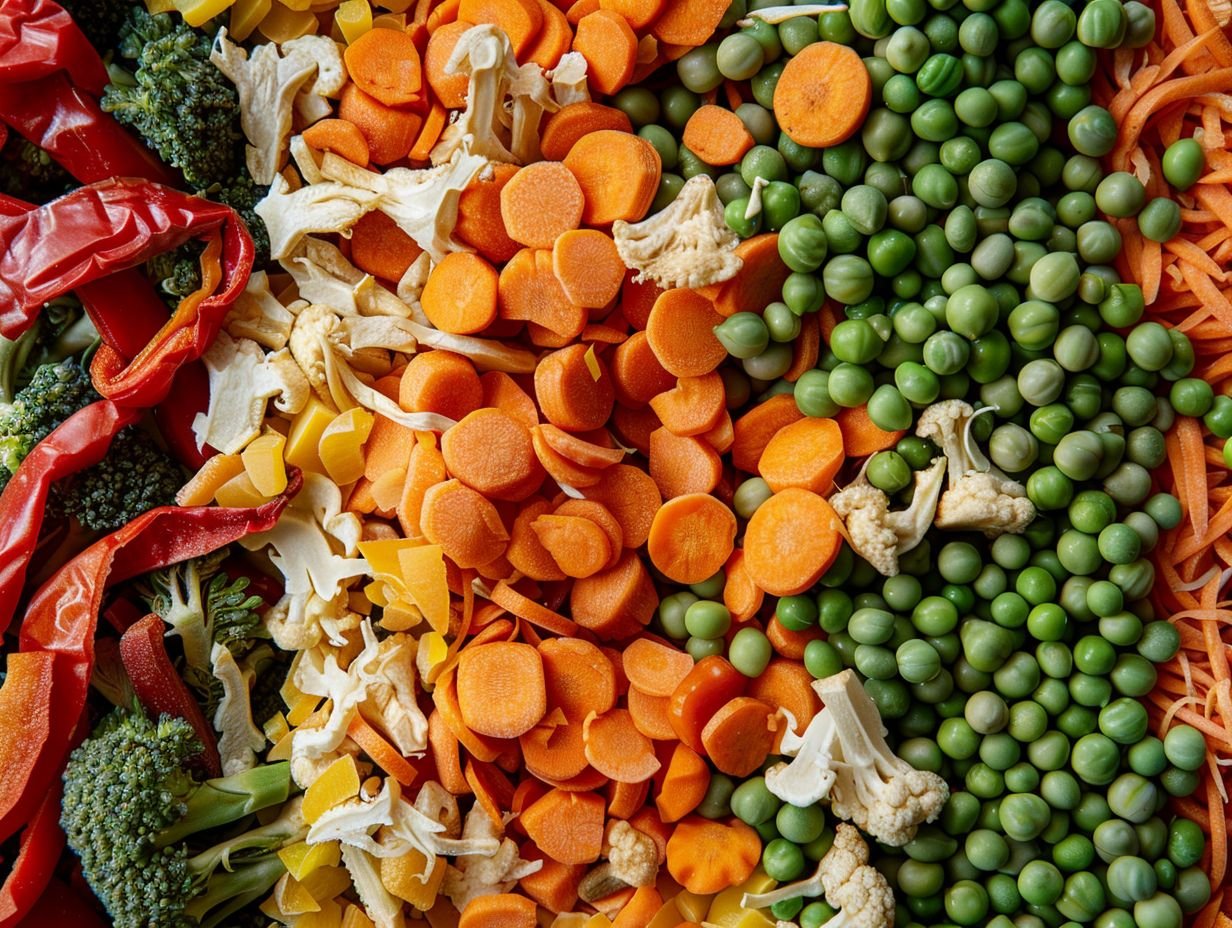
Dried vegetables make for a healthy and convenient snack or side dish, offering a nutrient-dense alternative to processed snacks.
When considering incorporating dried vegetables into your diet, you can opt for a variety of options such as dried carrots, bell peppers, or even tomatoes. These dehydrated goodies retain most of their nutritional value and can be easily rehydrated for use in soups, stews, or salads.
One of the key advantages of using dried vegetables is their extended shelf life. Unlike fresh produce, which may spoil quickly, dried vegetables can be stored for long periods without losing their quality. This makes them perfect for stocking up on nutritious ingredients that are ready to use at any time.
Dried vegetables are rich in essential vitamins, minerals, and fiber, making them a great choice for those looking to boost their daily nutrient intake. They also add a unique texture and flavor profile to dishes, enhancing the overall meal experience.
Rehydrating dried vegetables is a straightforward process that involves soaking them in boiling water, making them ready for use in various recipes.
Once the dried vegetables are rehydrated, they regain their natural texture and flavors, adding a burst of color and nutrients to dishes. To rehydrate, simply place the vegetables in a bowl, cover them with boiling water, and let them sit for about 15-20 minutes until they plump up. Drain any excess water before using the vegetables in your preferred dish.
Rehydrated vegetables can be a versatile addition to soups, stews, stir-fries, and salads. For soups and stews, add the rehydrated veggies during the last 10-15 min of cooking to prevent them from becoming mushy. In stir-fries, toss them in at the end to preserve their texture and crunch.
There are several popular types of dried vegetables that are commonly used in a variety of food products, each offering unique flavors and nutritional benefits.
Dried tomatoes are a rich source of beta carotene and other nutrients, making them a popular addition to many dishes.
These sun-dried gems pack a concentrated flavor punch, adding depth and complexity to salads, pasta, sandwiches, and dips. Tomatoes undergo a drying process that intensifies their natural sweetness, resulting in a chewy texture that can elevate both savory and sweet dishes.
Along with their flavor-enhancing qualities, dried tomatoes also boast impressive nutritional benefits. They are packed with antioxidants, vitamins, and minerals, such as vitamin C, potassium, and fiber, which contribute to overall health and well-being.
Dried mushrooms are packed with vitamins and minerals, offering a concentrated source of nutrients that can enhance the flavor and nutritional profile of various dishes.
One of the key benefits of using dried mushrooms in your cooking is their long shelf life, making them a convenient pantry staple that can be readily available whenever needed. Dried mushrooms boast a rich umami flavor that adds depth and complexity to soups, stews, sauces, and risottos.
Another advantage is their versatility – you can rehydrate dried mushrooms by soaking them in hot water, or grind them into a powder for seasoning blends or rubs. This flexibility allows you to experiment with different flavor profiles and textures in your culinary creations.
Dried peppers are an excellent source of vitamin C and add a burst of flavor to any dish, making them a favorite ingredient in many cuisines.
Dried peppers are known to have antioxidant properties, which can help boost the immune system and reduce inflammation in the body. They are also low in calories, making them a great addition to a healthy diet. When preparing dried peppers, it’s important to soak them in warm water for about 20-30 minutes to soften them before use. This will not only rehydrate the peppers but also enhance their flavors.
One popular culinary use of dried peppers is in making homemade chili powder. You can easily grind dried peppers into a fine powder using a spice grinder or mortar and pestle. This homemade chili powder can then be used to season meats, soups, stews, and sauces.
Dried spinach retains many of the nutrients found in fresh leafy vegetables, making it a convenient and nutritious addition to various meals.
One of the key benefits of using dried spinach is its extended shelf life compared to fresh spinach, allowing you to have a readily available source of nutrients in your pantry. The concentrated nature of dried spinach means that you can easily incorporate it into a wide range of dishes, from soups and stews to smoothies and casseroles.
Another advantage of dried spinach is its versatility – you can use it as a flavorful seasoning, a health-boosting garnish, or even rehydrate it for a more substantial ingredient in salads, omelets, and pasta dishes. This adaptability makes dried spinach a valuable pantry staple for enhancing the nutritional content of your meals.
Dried onions are a flavorful and convenient option for adding depth to numerous dishes, from soups to stir fries.
One of the key advantages of using dried onions in cooking is their extended shelf life, allowing you to have this essential ingredient readily available at all times. Whether you are preparing a quick weeknight meal or an elaborate feast, dried onions can be a time-saving solution that imparts a rich flavor profile to your dishes.
The versatility of dried onions is another reason why they are beloved by home cooks and professional chefs alike. From enhancing the taste of marinades and salad dressings to being a crucial component in spice blends, dried onions can elevate the overall taste of a wide range of recipes.
The nutritional value of dried vegetables is similar to that of fresh vegetables, as the dehydration process preserves most of the nutrients. Dried vegetables are a good source of fiber, vitamins, and minerals.
Yes, dried vegetables are a healthy option as they have low fat content and retain their nutritional value. They are also a good source of essential nutrients and can be used in a variety of dishes.
Dried vegetables are preserved through the dehydration process, which involves removing the water content from the vegetables. This method helps to prevent spoilage and increases the shelf life of vegetables.
Yes, one of the main benefits of dried vegetables is their long shelf life. With proper storage, they can last for months and even up to a year, making them a convenient option for stocking up on vegetables.
Yes, dried vegetables are very convenient to use as they are lightweight and do not require refrigeration. They are also pre-cut and pre-cooked, making them a time-saving option for busy individuals.
Dried vegetables can be rehydrated and used in a variety of dishes, such as soups, stews, and casseroles. They can also be added to salads, sandwiches, and even smoothies for a nutritious boost.